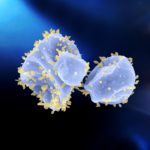Lien DOI – 10.1093/femsml/uqab007
microLife. 2021 Jun; 2:uqab007
Membrane-bound extracellular vesicles (EVs) are secreted by cells from all three domains of life and their implication in various biological processes is increasingly recognized. In this review, we summarize the current knowledge on archaeal EVs and nanotubes, and emphasize their biological significance. In archaea, the EVs and nanotubes have been largely studied in representative species from the phyla Crenarchaeota and Euryarchaeota. The archaeal EVs have been linked to several physiological processes such as detoxification, biomineralization and transport of biological molecules, including chromosomal, viral or plasmid DNA, thereby taking part in genome evolution and adaptation through horizontal gene transfer. The biological significance of archaeal nanotubes is yet to be demonstrated, although they could participate in EV biogenesis or exchange of cellular contents. We also discuss the biological mechanisms leading to EV/nanotube biogenesis in Archaea. It has been recently demonstrated that, similar to eukaryotes, EV budding in crenarchaea depends on the ESCRT machinery, whereas the mechanism of EV budding in euryarchaeal lineages, which lack the ESCRT-III homologues, remains unknown.



